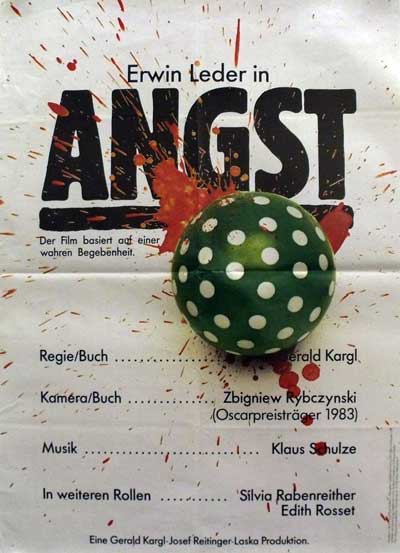 An Austrian serial killer drama, similar in vain to classics like M and HENRY: PORTRAIT OF A SERIAL KILLER. Many respected critics have dubbed it a masterpiece. Not me!
An Austrian serial killer drama, similar in vain to classics like M and HENRY: PORTRAIT OF A SERIAL KILLER. Many respected critics have dubbed it a masterpiece. Not me!
I know little about this 1983 film’s production and distribution history, but am aware of the small but loyal following it has amassed over the years. Just check out the enthusiastic user comments on the IMDB, as well as a rave review in a past issue of Shock Cinema. It was also a reported inspiration on I STAND ALONE director Gaspar Noe, who has publicly expressed great adulation for the film.
ANGST (a.k.a. FEAR and SCHIZOPHRENIA) has a fair share of admirers who tend to single out its innovative camerawork, elegant simplicity, and unflinching realism. The last category is the only one I really agree with; this film, set in real time, is definitely gritty, and may be the least sensationalized account of a serial killer ever. If nothing else, the psycho on display here is definitely the most staggeringly inept mass murderer I’ve seen in any film.
Elegant simplicity? Maybe, but there’s a fine line between simplicity and sheer boredom and this film crosses it in the first ten minutes. It follows a murderous spaz, just released from an insane asylum, who breaks into a house and murders a family. Like everything else he does, he manages to bungle this task spectacularly; he massacres the house’s occupants—an old woman, her invalid husband and their grown daughter—but makes a horrendous mess while doing it. Afterwards he drives erratically and acts weird in a bar, thus alerting the law and sealing his fate. Norman Bates this guy most definitely isn’t.
ANGST is, so far as I know, the only film made by director Gerald Kargl. His most notable contributions are the innovative visuals, in particular the floating camera shots that utilize a unique camera mount employed in SECONDS and MEAN STREETS. This device attaches cameras to actors’ shoulders, giving them (and us) a POV shot of themselves. The opening of ANGST is actually fairly impressive, enhancing this much-used device by introducing movement into it and drifting the camera around the main actor’s head. Unfortunately Kargl vastly overuses this innovation.
Many of ANGST’S technical elements are impressive, including a nicely ominous music cue and some disturbingly convincing gore FX—but they’re blunted by overuse. Watch any ten minutes of this film and you’ll think you’re seeing something great…just don’t try sitting through the whole thing!
There is something to be said, I guess, for the film’s unwavering focus, but again, it grows tiresome quickly. The lack of cutaways (voice-overs fill us in on the protagonist’s horrendous life story), subplots or supporting characters means we’re stuck watching a nerd who is neither complex, sympathetic or even particularly menacing. The drawn-out murder sequences are harrowingly graphic, but their impact is diminished by the fact that the majority of the film consists of its main character fumbling around. If ANGST ultimately proves anything, it’s the fallacy of taking audiences into the minds of serial killers-–this film shows (intentionally or otherwise) that sometimes there just isn’t much worth showing.
Vital Statistics
ANGST (a.k.a. FEAR; SCHIZOPHRENIA)
Director: Gerald Kargl
Screenplay: Gerald Kargl, Zbigniew Rybczynski
Cinematography: Zbigniew Rybczynski
Cast: Rudolf Gotz, Erwin Leder, Silvia Rabenreither, Edith Rosset
